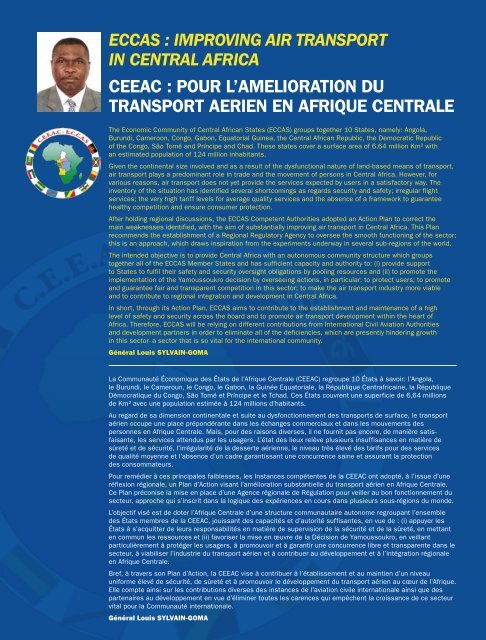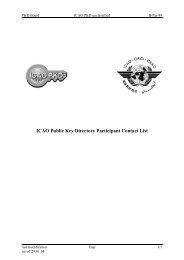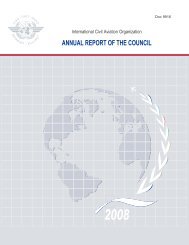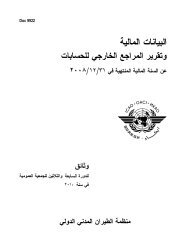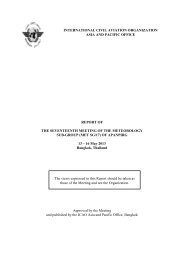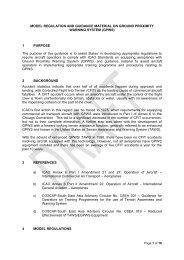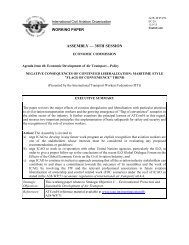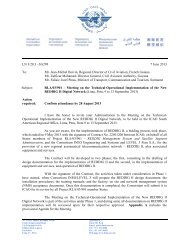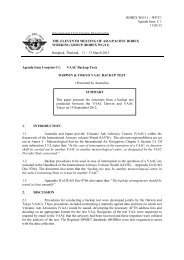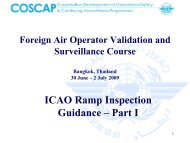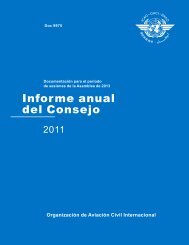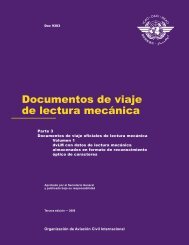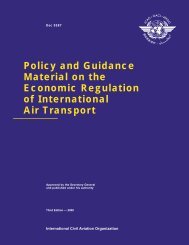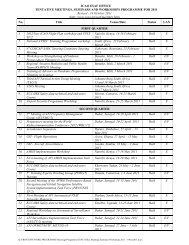Joint Western & Central African (WACAF) Office and - ICAO
Joint Western & Central African (WACAF) Office and - ICAO
Joint Western & Central African (WACAF) Office and - ICAO
Create successful ePaper yourself
Turn your PDF publications into a flip-book with our unique Google optimized e-Paper software.
ECCAS : IMPROVING AIR TRANSPORT<br />
IN CENTRAL AFRICA<br />
CEEAC : POUR L’AMELIORATION DU<br />
TRANSPORT AERIEN EN AFRIQUE CENTRALE<br />
The Economic Community of <strong>Central</strong> <strong>African</strong> States (ECCAS) groups together 10 States, namely: Angola,<br />
Burundi, Cameroon, Congo, Gabon, Equatorial Guinea, the <strong>Central</strong> <strong>African</strong> Republic, the Democratic Republic<br />
of the Congo, São Tomé <strong>and</strong> Príncipe <strong>and</strong> Chad. These states cover a surface area of 6.64 million Km² with<br />
an estimated population of 124 million inhabitants.<br />
Given the continental size involved <strong>and</strong> as a result of the dysfunctional nature of l<strong>and</strong>-based means of transport,<br />
air transport plays a predominant role in trade <strong>and</strong> the movement of persons in <strong>Central</strong> Africa. However, for<br />
various reasons, air transport does not yet provide the services expected by users in a satisfactory way. The<br />
inventory of the situation has identified several shortcomings as regards security <strong>and</strong> safety; irregular flight<br />
services; the very high tariff levels for average quality services <strong>and</strong> the absence of a framework to guarantee<br />
healthy competition <strong>and</strong> ensure consumer protection.<br />
After holding regional discussions, the ECCAS Competent Authorities adopted an Action Plan to correct the<br />
main weaknesses identified, with the aim of substantially improving air transport in <strong>Central</strong> Africa. This Plan<br />
recommends the establishment of a Regional Regulatory Agency to oversee the smooth functioning of the sector;<br />
this is an approach, which draws inspiration from the experiments underway in several sub-regions of the world.<br />
The intended objective is to provide <strong>Central</strong> Africa with an autonomous community structure which groups<br />
together all of the ECCAS Member States <strong>and</strong> has sufficient capacity <strong>and</strong> authority to: (i) provide support<br />
to States to fulfil their safety <strong>and</strong> security oversight obligations by pooling resources <strong>and</strong> (ii) to promote the<br />
implementation of the Yamoussoukro decision by overseeing actions, in particular: to protect users; to promote<br />
<strong>and</strong> guarantee fair <strong>and</strong> transparent competition in this sector; to make the air transport industry more viable<br />
<strong>and</strong> to contribute to regional integration <strong>and</strong> development in <strong>Central</strong> Africa.<br />
In short, through its Action Plan, ECCAS aims to contribute to the establishment <strong>and</strong> maintenance of a high<br />
level of safety <strong>and</strong> security across the board <strong>and</strong> to promote air transport development within the heart of<br />
Africa. Therefore, ECCAS will be relying on different contributions from International Civil Aviation Authorities<br />
<strong>and</strong> development partners in order to eliminate all of the deficiencies, which are presently hindering growth<br />
in this sector- a sector that is so vital for the international community.<br />
Général Louis SYLVAIN-GOMA<br />
La Communauté Économique des États de l’Afrique <strong>Central</strong>e (CEEAC) regroupe 10 États à savoir: l’Angola,<br />
le Burundi, le Cameroun, le Congo, le Gabon, la Guinée Equatoriale, la République Centrafricaine, la République<br />
Démocratique du Congo, São Tomé et Príncipe et le Tchad. Ces États couvrent une superficie de 6,64 millions<br />
de Km² avec une population estimée à 124 millions d’habitants.<br />
Au regard de sa dimension continentale et suite au dysfonctionnement des transports de surface, le transport<br />
aérien occupe une place prépondérante dans les échanges commerciaux et dans les mouvements des<br />
personnes en Afrique <strong>Central</strong>e. Mais, pour des raisons diverses, il ne fournit pas encore, de manière satisfaisante,<br />
les services attendus par les usagers. L’état des lieux relève plusieurs insuffisances en matière de<br />
sûreté et de sécurité, l’irrégularité de la desserte aérienne, le niveau très élevé des tarifs pour des services<br />
de qualité moyenne et l’absence d’un cadre garantissant une concurrence saine et assurant la protection<br />
des consommateurs.<br />
Pour remédier à ces principales faiblesses, les Instances compétentes de la CEEAC ont adopté, à l’issue d’une<br />
réflexion régionale, un Plan d’Action visant l’amélioration substantielle du transport aérien en Afrique <strong>Central</strong>e.<br />
Ce Plan préconise la mise en place d’une Agence régionale de Régulation pour veiller au bon fonctionnement du<br />
secteur, approche qui s’inscrit dans la logique des expériences en cours dans plusieurs sous-régions du monde.<br />
L’objectif visé est de doter l’Afrique <strong>Central</strong>e d’une structure communautaire autonome regroupant l’ensemble<br />
des États membres de la CEEAC, jouissant des capacités et d’autorité suffisantes, en vue de : (i) appuyer les<br />
États à s’acquitter de leurs responsabilités en matière de supervision de la sécurité et de la sûreté, en mettant<br />
en commun les ressources et (ii) favoriser la mise en œuvre de la Décision de Yamoussoukro, en veillant<br />
particulièrement à protéger les usagers, à promouvoir et à garantir une concurrence libre et transparente dans le<br />
secteur, à viabiliser l’industrie du transport aérien et à contribuer au développement et à l’intégration régionale<br />
en Afrique <strong>Central</strong>e.<br />
Bref, à travers son Plan d’Action, la CEEAC vise à contribuer à l’établissement et au maintien d’un niveau<br />
uniforme élevé de sécurité, de sûreté et à promouvoir le développement du transport aérien au cœur de l’Afrique.<br />
Elle compte ainsi sur les contributions diverses des instances de l’aviation civile internationale ainsi que des<br />
partenaires au développement en vue d’éliminer toutes les carences qui empêchent la croissance de ce secteur<br />
vital pour la Communauté internationale.<br />
Général Louis SYLVAIN-GOMA


